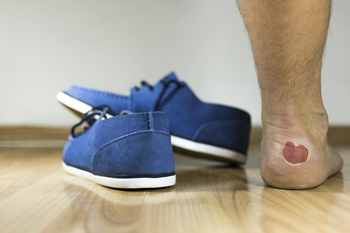Blog - Foot Doctor, Chambersburg and McConnellsburg, PA
How Can I Tell If I Have a Hammertoe?
 Research has found that the second toe, next to the big toe, is most likely to develop a hammertoe if an injury occurs, along with other causes. Hammertoes typically occur due to genetic factors, ill-fitting footwear, or from arthritis. This condition is most notably recognized by the appearance of the affected toe. Like its name suggests, a hammertoe will typically point downward, in a hammer-like fashion. Hammertoes can be incredibly uncomfortable and can make completing daily tasks difficult. To help ease the pain of mild hammertoes, a professional may suggest wearing custom orthotics. For more severe cases, it may be necessary to have surgery performed in order to correct this ailment. For more advice on how to treat and correct a hammertoe, please consult with a podiatrist.
Research has found that the second toe, next to the big toe, is most likely to develop a hammertoe if an injury occurs, along with other causes. Hammertoes typically occur due to genetic factors, ill-fitting footwear, or from arthritis. This condition is most notably recognized by the appearance of the affected toe. Like its name suggests, a hammertoe will typically point downward, in a hammer-like fashion. Hammertoes can be incredibly uncomfortable and can make completing daily tasks difficult. To help ease the pain of mild hammertoes, a professional may suggest wearing custom orthotics. For more severe cases, it may be necessary to have surgery performed in order to correct this ailment. For more advice on how to treat and correct a hammertoe, please consult with a podiatrist.
Hammertoes can be a painful condition to live with. For more information, contact Dr. Steven Schwartz of Pennsylvania. Our doctor will answer any of your foot- and ankle-related questions.
Hammertoe
Hammertoe is a foot deformity that occurs due to an imbalance in the muscles, tendons, or ligaments that normally hold the toe straight. It can be caused by the type of shoes you wear, your foot structure, trauma, and certain disease processes.
Symptoms
- Painful and/or difficult toe movement
- Swelling
- Joint stiffness
- Calluses/Corns
- Physical deformity
Risk Factors
- Age – The risk of hammertoe increases with age
- Sex – Women are more likely to have hammertoe compared to men
- Toe Length – You are more likely to develop hammertoe if your second toe is longer than your big toe
- Certain Diseases – Arthritis and diabetes may make you more likely to develop hammertoe
Treatment
If you have hammertoe, you should change into a more comfortable shoe that provides enough room for your toes. Exercises such as picking up marbles may strengthen and stretch your toe muscles. Nevertheless, it is important to seek assistance from a podiatrist in order to determine the severity of your hammertoe and see which treatment option will work best for you.
If you have any questions, please feel free to contact our offices located in Chambersburg, and Mcconnellsburg, PA . We offer the newest diagnostic and treatment technologies for all your foot care needs.
Stress Fractures Develop Gradually
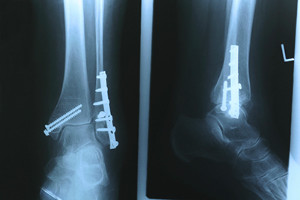 A stress fracture is often referred to as a hairline fracture, and typically develops gradually. It occurs as a result of a weakened bone in the foot, and this may happen from frequently participating in walking and running activities. Additionally, it can become a common issue if the running surface changes, or possibly from starting to train too soon after an injury occurs. Some of the symptoms that are associated with this condition can include swelling on or around the affected area, and experiencing pain while walking. Effective treatment can begin by refraining from the activity that caused the injury, and elevating the affected foot to help reduce existing swelling. If you have a stress fracture, please schedule an appointment with a podiatrist who can help you with exploring your treatment options.
A stress fracture is often referred to as a hairline fracture, and typically develops gradually. It occurs as a result of a weakened bone in the foot, and this may happen from frequently participating in walking and running activities. Additionally, it can become a common issue if the running surface changes, or possibly from starting to train too soon after an injury occurs. Some of the symptoms that are associated with this condition can include swelling on or around the affected area, and experiencing pain while walking. Effective treatment can begin by refraining from the activity that caused the injury, and elevating the affected foot to help reduce existing swelling. If you have a stress fracture, please schedule an appointment with a podiatrist who can help you with exploring your treatment options.
Stress fractures occur when there is a tiny crack within a bone. To learn more, contact Dr. Steven Schwartz from Pennsylvania. Our doctor can provide the care you need to keep you pain free and on your feet.
How Are They Caused?
Stress fractures are the result of repetitive force being placed on the bone. Since the lower leg and feet often carry most of the body’s weight, stress fractures are likely to occur in these areas. If you rush into a new exercise, you are more likely to develop a stress fracture since you are starting too much, too soon. Pain resulting from stress fractures may go unnoticed at first, however it may start to worsen over time.
Risk Factors
- Gender – They are more commonly found in women compared to men.
- Foot Problems – People with unusual arches in their feet are more likely to develop stress fractures.
- Certain Sports – Dancers, gymnasts, tennis players, runners, and basketball players are more likely to develop stress fractures.
- Lack of Nutrients – A lack of vitamin D and calcium may weaken the bones and make you more prone to stress fractures
- Weak Bones – Osteoporosis can weaken the bones therefore resulting in stress fractures
Stress fractures do not always heal properly, so it is important that you seek help from a podiatrist if you suspect you may have one. Ignoring your stress fracture may cause it to worsen, and you may develop chronic pain as well as additional fractures.
If you have any questions, please feel free to contact our offices located in Chambersburg, and Mcconnellsburg, PA . We offer the newest diagnostic and treatment technologies for all your foot care needs.
Can Stretching The Feet Help Tarsal Tunnel Syndrome?
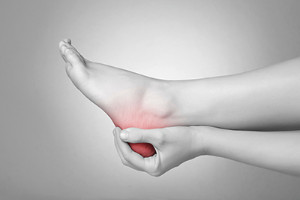 Patients who have the medical condition that is known as tarsal tunnel syndrome can experience several symptoms. These may include a numbing sensation on the inside of the ankle, pain and discomfort after walking for long periods of time, and the toes may feel weak. Having flat feet may play a significant role in developing tarsal tunnel syndrome, and it can gradually develop from conditions such as arthritis and varicose veins. If you are afflicted with this ailment, it is beneficial to elevate the affected foot as often as possible, in addition to strengthening the muscles and tendons by performing specific stretches. These can include circling your ankles from left to right for several seconds, followed by changing direction. It may feel good to raise and lower your toes throughout the day, and stretching the plantar fascia may help the foot to generally feel better. Please consult with a podiatrist to learn more about possible treatment techniques for tarsal tunnel syndrome.
Patients who have the medical condition that is known as tarsal tunnel syndrome can experience several symptoms. These may include a numbing sensation on the inside of the ankle, pain and discomfort after walking for long periods of time, and the toes may feel weak. Having flat feet may play a significant role in developing tarsal tunnel syndrome, and it can gradually develop from conditions such as arthritis and varicose veins. If you are afflicted with this ailment, it is beneficial to elevate the affected foot as often as possible, in addition to strengthening the muscles and tendons by performing specific stretches. These can include circling your ankles from left to right for several seconds, followed by changing direction. It may feel good to raise and lower your toes throughout the day, and stretching the plantar fascia may help the foot to generally feel better. Please consult with a podiatrist to learn more about possible treatment techniques for tarsal tunnel syndrome.
Tarsal tunnel syndrome can be very uncomfortable to live with. If you are experiencing tarsal tunnel syndrome, contact Dr. Steven Schwartz of Pennsylvania. Our doctor can provide the care you need to keep you pain-free and on your feet.
Tarsal Tunnel Syndrome
Tarsal tunnel syndrome, which can also be called tibial nerve dysfunction, is an uncommon condition of misfiring peripheral nerves in the foot. The tibial nerve is the peripheral nerve in the leg responsible for sensation and movement of the foot and calf muscles. In tarsal tunnel syndrome, the tibial nerve is damaged, causing problems with movement and feeling in the foot of the affected leg.
Common Cause of Tarsal Tunnel Syndrome
- Involves pressure or an injury, direct pressure on the tibial nerve for an extended period of time, sometimes caused by other body structures close by or near the knee.
- Diseases that damage nerves, including diabetes, may cause tarsal tunnel syndrome.
- At times, tarsal tunnel syndrome can appear without an obvious cause in some cases.
The Effects of Tarsal Tunnel Syndrome
- Different sensations, an afflicted person may experience pain, tingling, burning or other unusual sensations in the foot of the affected leg.
- The foot muscles, toes and ankle become weaker, and curling your toes or flexing your foot can become difficult.
- If condition worsens, infections and ulcers may develop on the foot that is experiencing the syndrome.
A physical exam of the leg can help identify the presence of tarsal tunnel syndrome. Medical tests, such as a nerve biopsy, are also used to diagnose the condition. Patients may receive physical therapy and prescriptive medication. In extreme cases, some may require surgery.
If you have any questions please feel free to contact our offices located in Chambersburg, and Mcconnellsburg, PA . We offer the newest diagnostic and treatment technologies for all your foot and ankle needs.
Do I Have a Severe or Mild Ankle Sprain?
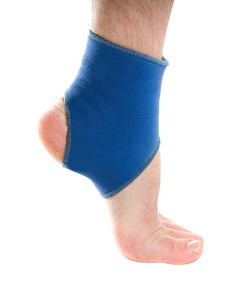 An injury that has damaged the ligaments of the ankle is often referred to as an ankle sprain. If the ligaments completely tear, the sprain is said to be severe, and can produce extreme pain and discomfort. If the ligaments become irritated, you may have endured a mild ankle sprain, and this may happen as a result of overstretching. Once the injury has occurred, a proper diagnosis is typically performed, which can be helpful in ruling out a broken ankle. Many patients find it beneficial to wrap the affected ankle in an elastic bandage, as this aids in providing necessary support as the healing process occurs. If you feel you have sprained your ankle, please consult with a podiatrist as quickly as possible so they can effectively treat this condition.
An injury that has damaged the ligaments of the ankle is often referred to as an ankle sprain. If the ligaments completely tear, the sprain is said to be severe, and can produce extreme pain and discomfort. If the ligaments become irritated, you may have endured a mild ankle sprain, and this may happen as a result of overstretching. Once the injury has occurred, a proper diagnosis is typically performed, which can be helpful in ruling out a broken ankle. Many patients find it beneficial to wrap the affected ankle in an elastic bandage, as this aids in providing necessary support as the healing process occurs. If you feel you have sprained your ankle, please consult with a podiatrist as quickly as possible so they can effectively treat this condition.
Ankle sprains are common but need immediate attention. If you need your feet checked, contact Dr. Steven Schwartz from Pennsylvania. Our doctor can provide the care you need to keep you pain-free and on your feet.
How Does an Ankle Sprain Occur?
Ankle sprains take place when the ligaments in your ankle are torn or stretched beyond their limits. There are multiple ways that the ankle can become injured, including twisting or rolling over onto your ankle, putting undue stress on it, or causing trauma to the ankle itself.
What Are the Symptoms?
- Mild to moderate bruising
- Limited mobility
- Swelling
- Discoloration of the skin (depending on severity)
Preventing a Sprain
- Wearing appropriate shoes for the occasion
- Stretching before exercises and sports
- Knowing your limits
Treatment of a Sprain
Treatment of a sprain depends on the severity. Many times, people are told to rest and remain off their feet completely, while others are given an air cast. If the sprain is very severe, surgery may be required.
If you have suffered an ankle sprain previously, you may want to consider additional support such as a brace and regular exercises to strengthen the ankle.
If you have any questions please feel free to contact our offices located in Chambersburg, and Mcconnellsburg, PA . We offer the newest diagnostic and treatment technologies for all your foot and ankle needs.
What Symptoms are Indicative of Morton’s Neuroma?
 One common cause of Morton’s neuroma includes wearing footwear that is too tight for your feet. This condition may occur when a nerve between the toes becomes pinched and inflamed, often causing a numbing or tingling feeling in the affected foot. Some patients have also expressed it felt as if they were walking with a pebble in their shoe, as well as a burning felt in the forefoot. Along with ill fitting footwear, certain foot deformities may also be a factor in the development of Morton’s neuroma. Some conditions that increase your risk of developing a neuroma may include hammertoes and bunions. To help alleviate some of the discomfort associated with this condition, patients have found using insoles and custom orthotics to be quite helpful. If you believe you have developed Morton’s neuroma and would like more information on how to treat this condition, it is suggested that you speak with a podiatrist.
One common cause of Morton’s neuroma includes wearing footwear that is too tight for your feet. This condition may occur when a nerve between the toes becomes pinched and inflamed, often causing a numbing or tingling feeling in the affected foot. Some patients have also expressed it felt as if they were walking with a pebble in their shoe, as well as a burning felt in the forefoot. Along with ill fitting footwear, certain foot deformities may also be a factor in the development of Morton’s neuroma. Some conditions that increase your risk of developing a neuroma may include hammertoes and bunions. To help alleviate some of the discomfort associated with this condition, patients have found using insoles and custom orthotics to be quite helpful. If you believe you have developed Morton’s neuroma and would like more information on how to treat this condition, it is suggested that you speak with a podiatrist.
Morton’s neuroma is a very uncomfortable condition to live with. If you think you have Morton’s neuroma, contact Dr. Steven Schwartz of Pennsylvania. Our doctor will attend to all of your foot care needs and answer any of your related questions.
Morton’s Neuroma
Morton's neuroma is a painful foot condition that commonly affects the areas between the second and third or third and fourth toe, although other areas of the foot are also susceptible. Morton’s neuroma is caused by an inflamed nerve in the foot that is being squeezed and aggravated by surrounding bones.
What Increases the Chances of Having Morton’s Neuroma?
- Ill-fitting high heels or shoes that add pressure to the toe or foot
- Jogging, running or any sport that involves constant impact to the foot
- Flat feet, bunions, and any other foot deformities
Morton’s neuroma is a very treatable condition. Orthotics and shoe inserts can often be used to alleviate the pain on the forefront of the feet. In more severe cases, corticosteroids can also be prescribed. In order to figure out the best treatment for your neuroma, it’s recommended to seek the care of a podiatrist who can diagnose your condition and provide different treatment options.
If you have any questions, please feel free to contact our offices located in Chambersburg, and Mcconnellsburg, PA . We offer the newest diagnostic and treatment technologies for all your foot care needs.
Do I Have a Heel Spur?
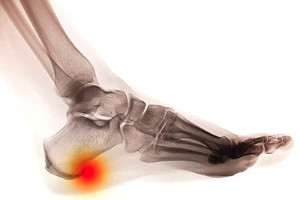 The medical condition that is known as a heel spur typically develops from inflammation that happens to the plantar fascia. It is defined as a bony growth that forms on the heel, and can cause pain and discomfort. Some of the reasons why this condition may develop can include sudden weight gain, wearing shoes that do not have adequate cushioning, or existing conditions that may include flat feet. The symptoms that patients experience can consist of pain in the heel and surrounding areas, and the foot may feel stiff upon arising in the morning. Research has indicated that mild relief may be found when orthotics are worn in the shoes, as this may be helpful in reducing pressure on the heel. If you have developed a heel spur, it is suggested that you consult with a podiatrist who can offer you correct treatment options.
The medical condition that is known as a heel spur typically develops from inflammation that happens to the plantar fascia. It is defined as a bony growth that forms on the heel, and can cause pain and discomfort. Some of the reasons why this condition may develop can include sudden weight gain, wearing shoes that do not have adequate cushioning, or existing conditions that may include flat feet. The symptoms that patients experience can consist of pain in the heel and surrounding areas, and the foot may feel stiff upon arising in the morning. Research has indicated that mild relief may be found when orthotics are worn in the shoes, as this may be helpful in reducing pressure on the heel. If you have developed a heel spur, it is suggested that you consult with a podiatrist who can offer you correct treatment options.
Heel spurs can be incredibly painful and sometimes may make you unable to participate in physical activities. To get medical care for your heel spurs, contact Dr. Steven Schwartz from Pennsylvania. Our doctor will do everything possible to treat your condition.
Heels Spurs
Heel spurs are formed by calcium deposits on the back of the foot where the heel is. This can also be caused by small fragments of bone breaking off one section of the foot, attaching onto the back of the foot. Heel spurs can also be bone growth on the back of the foot and may grow in the direction of the arch of the foot.
Older individuals usually suffer from heel spurs and pain sometimes intensifies with age. One of the main condition's spurs are related to is plantar fasciitis.
Pain
The pain associated with spurs is often because of weight placed on the feet. When someone is walking, their entire weight is concentrated on the feet. Bone spurs then have the tendency to affect other bones and tissues around the foot. As the pain continues, the feet will become tender and sensitive over time.
Treatments
There are many ways to treat heel spurs. If one is suffering from heel spurs in conjunction with pain, there are several methods for healing. Medication, surgery, and herbal care are some options.
If you have any questions feel free to contact our offices located in Chambersburg, and Mcconnellsburg, PA . We offer the latest in diagnostic and treatment technology to meet your needs.
What Steps Should I Take If I’ve Developed a Foot Wound?
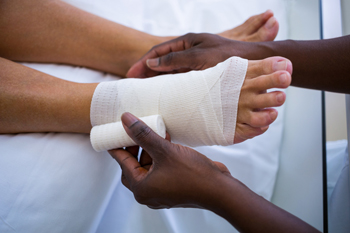 If a wound has developed on your foot, it’s extremely important that you identify which kind of wound it is and take the necessary steps to ensure it heals safely and properly. Oftentimes, wounds go unnoticed on the feet, which is why you should check them daily for any abnormalities. Some common types of wounds that can form include scrapes, abrasions, cuts, or puncture wounds. To care for your wounds, you should begin by washing the affected area with soap and water, followed by thoroughly drying the feet. An antibiotic ointment should then be applied, followed by fully covering the wound. If you find the damaged area has not stopped bleeding after a few hours, professional help should be sought, as stitches may be required. If you also experience redness, swelling, pain, drainage from the wound, or develop a fever, you should seek professional care, as this may be signs that the wound has become infected. In order to safely treat any wounds of the feet, consult with a podiatrist for professional care and an advised plan of action.
If a wound has developed on your foot, it’s extremely important that you identify which kind of wound it is and take the necessary steps to ensure it heals safely and properly. Oftentimes, wounds go unnoticed on the feet, which is why you should check them daily for any abnormalities. Some common types of wounds that can form include scrapes, abrasions, cuts, or puncture wounds. To care for your wounds, you should begin by washing the affected area with soap and water, followed by thoroughly drying the feet. An antibiotic ointment should then be applied, followed by fully covering the wound. If you find the damaged area has not stopped bleeding after a few hours, professional help should be sought, as stitches may be required. If you also experience redness, swelling, pain, drainage from the wound, or develop a fever, you should seek professional care, as this may be signs that the wound has become infected. In order to safely treat any wounds of the feet, consult with a podiatrist for professional care and an advised plan of action.
Wound care is an important part in dealing with diabetes. If you have diabetes and a foot wound or would like more information about wound care for diabetics, consult with Dr. Steven Schwartz from Pennsylvania. Our doctor will assess your condition and provide you with quality foot and ankle treatment.
What Is Wound Care?
Wound care is the practice of taking proper care of a wound. This can range from the smallest to the largest of wounds. While everyone can benefit from proper wound care, it is much more important for diabetics. Diabetics often suffer from poor blood circulation which causes wounds to heal much slower than they would in a non-diabetic.
What Is the Importance of Wound Care?
While it may not seem apparent with small ulcers on the foot, for diabetics, any size ulcer can become infected. Diabetics often also suffer from neuropathy, or nerve loss. This means they might not even feel when they have an ulcer on their foot. If the wound becomes severely infected, amputation may be necessary. Therefore, it is of the upmost importance to properly care for any and all foot wounds.
How to Care for Wounds
The best way to care for foot wounds is to prevent them. For diabetics, this means daily inspections of the feet for any signs of abnormalities or ulcers. It is also recommended to see a podiatrist several times a year for a foot inspection. If you do have an ulcer, run the wound under water to clear dirt from the wound; then apply antibiotic ointment to the wound and cover with a bandage. Bandages should be changed daily and keeping pressure off the wound is smart. It is advised to see a podiatrist, who can keep an eye on it.
If you have any questions, please feel free to contact our offices located in Chambersburg, and Mcconnellsburg, PA . We offer the newest diagnostic and treatment technologies for all your foot care needs.
How Can You Prevent a Blister From Forming?
Blisters may be characterized as fluid-filled sacs that form due to friction between the foot and tightly worn socks or shoes. Some blisters may also form due to a burn or injury. To help prevent a blister from developing, it is recommended that your footwear is neither too big nor too small, as that may increase rubbing between your foot and shoe. For runners especially, it is important that you change your running shoes about every 6 months to ensure a proper fit. Some patients have found keeping their feet dry by using a foot powder has been effective in preventing blisters as well. For extra support, you may want to try doubling your socks, or taping areas that are more susceptible to getting blisters, such as the back of the heel or your toes. For more advice on the treatment and prevention of blisters it is suggested that you speak with a podiatrist for professional care.
Blisters may appear as a single bubble or in a cluster. They can cause a lot of pain and may be filled with pus, blood, or watery serum. If your feet are hurting, contact Dr. Steven Schwartz of Pennsylvania. Our doctor can provide the care you need to keep you pain-free and on your feet.
Foot Blisters
Foot blisters are often the result of friction. This happens due to the constant rubbing from shoes, which can lead to pain.
What Are Foot Blisters?
A foot blister is a small fluid-filled pocket that forms on the upper-most layer of the skin. Blisters are filled with clear fluid and can lead to blood drainage or pus if the area becomes infected.
Symptoms
(Blister symptoms may vary depending on what is causing them)
- Bubble of skin filled with fluid
- Redness
- Moderate to severe pain
- Itching
Prevention & Treatment
In order to prevent blisters, you should be sure to wear comfortable shoes with socks that cushion your feet and absorb sweat. Breaking a blister open may increase your chances of developing an infection. However, if your blister breaks, you should wash the area with soap and water immediately and then apply a bandage to the affected area. If your blisters cause severe pain it is important that you call your podiatrist right away.
If you have any questions, please feel free to contact our offices located in Chambersburg, and Mcconnellsburg, PA . We offer the newest diagnostic and treatment technologies for all your foot care needs.


